
USEA Briefing: EPRI Speaks to USEA About the Struggles of Achieving Grid Stability Using Dispatchable and Non-Dispatchable Power Sources
By Benjamin Doggett
USEA 2019 Summer Intern
U.S. Energy Association-member Electric Power Research Institute said “demand and supply for electricity is an equation that we need to balance every second.”
EPRI Senior Program Manager Mike Caravaggio told stakeholders during a USEA briefing “Coal generation as a tool for grid flexibility and stability” on July 23 that non-dispatchable power sources like wind and solar aren’t able to accommodate for the variable day-to-day demand. This is the central problem with renewable resources, he said.
Wind and solar resources don’t have the ability to react to shifts in demand like coal and natural gas do. When there is a spike in demand more fossil fuels can be burned and when there is a lull, it can be toned down.
Caravaggio stressed the need for flexible power grids and the part that coal can play in that.
On top of that, the hours of the day when solar generation is at its peak are unfortunately the hours when demand for electricity is normally at its lowest. The times of day when demand for electricity peaks coincide with the time of day when solar generation is approaching zero.
Caravaggio points out that many critics of coal and gas look to battery storage technology as a way to utilize the excess power generated during times of low demand. While Caravaggio does agree that battery storage technology will play an increasing role in balancing the power grid, he says that it’s “a bridge too far to think that battery storage will replace our current dispatchable power suppliers in the next five or even 10 years.”
